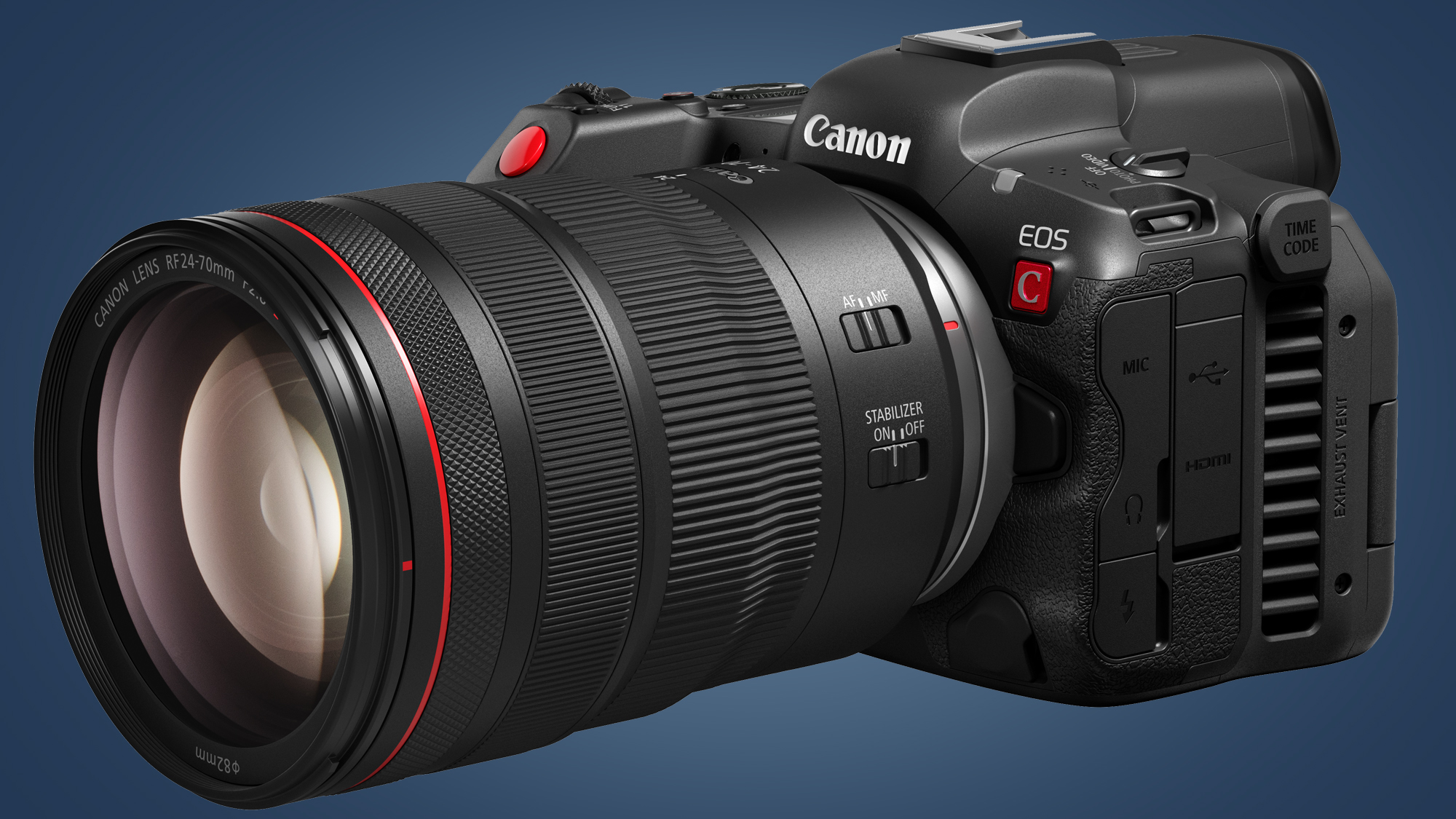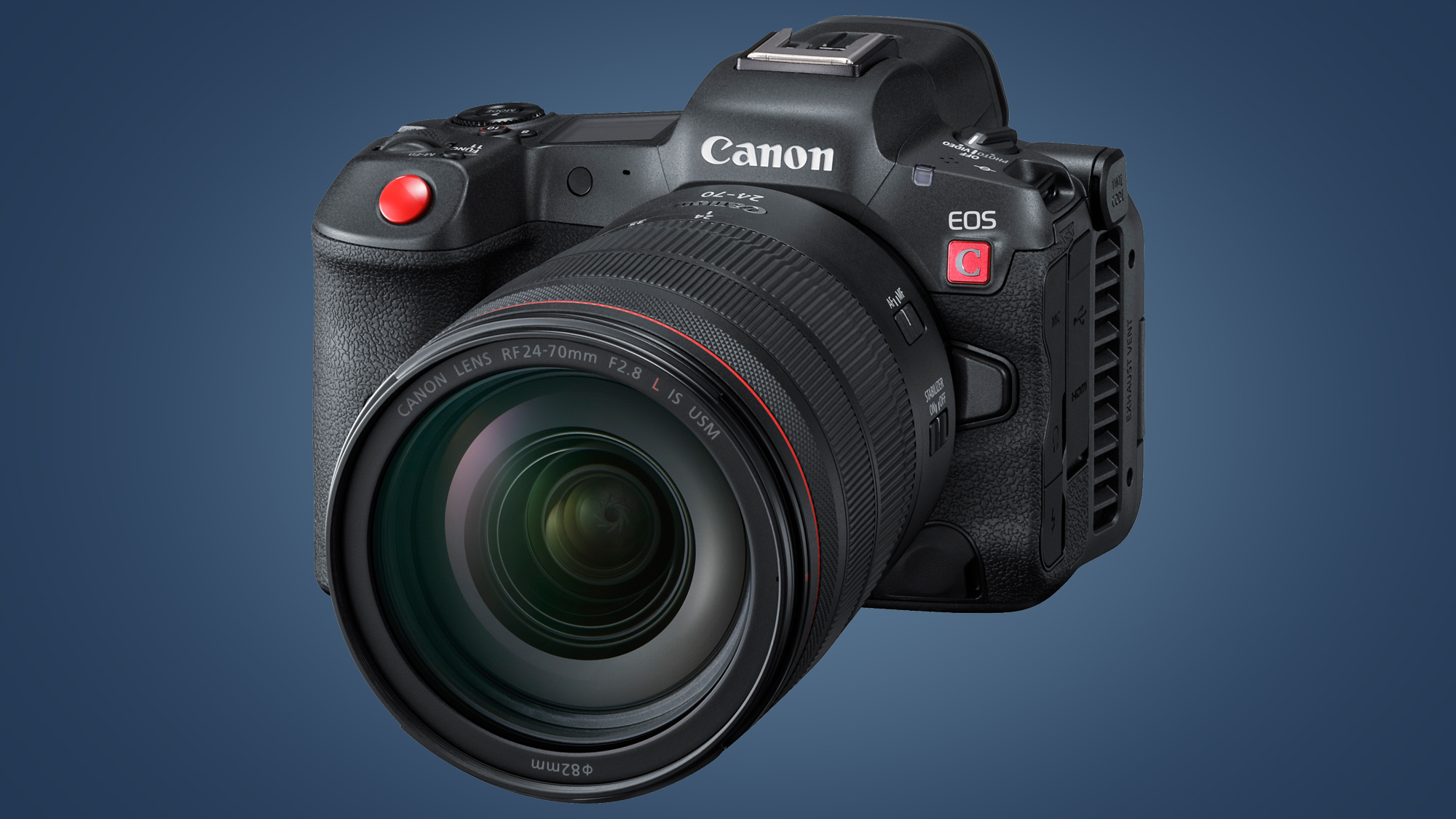The Canon EOS R5 C is a super-sized EOS R5 with cooling for unlimited 8K video

If the Canon EOS R5's video skills are too restrictive for your filmmaking needs, Canon has just given you a Cinema-flavored alternative called the Canon EOS R5 C.
A video-focused twist on the photography-focused EOS R5, the full-frame EOS R5 C effectively trades the latter's in-body image stabilization (IBIS) for a fan-powered cooling system that gives it virtually limitless 8K video shooting powers. Well, at least until your battery dies or your memory card fills up.
Unusually, the Canon EOS R5 C also features completely separate stills and video modes. While you're in 'photo' mode you can't shoot video at all – and vice versa. Instead, when switching between the two, the camera shuts down and reboots into your chosen stills or photo mode.
While this means the EOS R5 C isn't a true hybrid camera for those who want to quickly shoot a mixture of stills and video, it does make it a more powerful filmmaking tool than the EOS R5. Those cooling fans, in particular, solve the overheating criticisms leveled at the EOS R5, with the R5 C capable of shooting 8K/25p raw video internally for 50 minutes, or 4K/50p video for 35-40 minutes.

Feed the camera a 512GB CFexpress Type B card (the other slot is only for standard SD cards), and you'll be able to go for longer in formats like Cinema Raw Light, a compressed format that gives over an hour of recording from a charge. The EOS R5 C can even shoot 8K/60p video – although unlike the Nikon Z9, this will only be possible when it's hooked up to an external power source.
Despite the EOS R5 C's strong video focus (it is a Cinema EOS camera, after all), it does also have quite a lot in common with the EOS R5. Both cameras have the same RF lens mount, 45MP CMOS sensor, 5.76-million dot electronic viewfinder, and 3.2-inch rear touchscreen. The two mirrorless powerhouses also both have a Digic X processor, although Canon says these are tailored slightly for each camera.
This means that, unlike the EOS R5, the EOS R5 C's autofocus modes vary depending on whether you're shooting stills or video. In photo mode, you get the usual Dual Pixel CMOS AF II (complete with features like animal-tracking), but in video mode this switches to the standard Dual Pixel CMOS AF (the same experience as on the Canon EOS C70). This mode lacks the ability to track animals or motorsports, though pro filmmakers are unlikely to rely on autofocus in these situations anyway.
Sign up for breaking news, reviews, opinion, top tech deals, and more.
While the EOS R5 C does gain the useful Multi-Function shoe seen on the Canon EOS R3 – which gives it two-way data transfer with accessories like microphones and Speedlites – it does, unlike the EOS R5, lack in-body image stabilization. This is likely a dealbreaker for stills-focused creators, but filmmakers will most likely use their own stabilization, like a gimbal or monopod, with the EOS R5 C, so it's less of an issue for them.
The Canon EOS R5 C will be available in March for $4,499 / £4,499 / AU$7,499, which puts it in between the Canon EOS R5 (which launched for $3,899 / £4,199 / AU$6,899) and the Canon EOS C70 ($5,499 / £4,799 / AU$8,149). How much stock of the EOS R5 C will be available, though, remains to be seen – the recent Canon EOS R3 sold out very quickly, with Canon forecasting a wait up to six months for that camera back in December.
Analysis: a video powerhouse that's more Sony FX3 than Sony A1

The Canon EOS R5 C is a powerful new option for filmmakers who need a small, 8K video tool that can shoot pro-quality footage with a side of stills. But it's more like Canon's answer to the Sony FX3 than a more mainstream all-rounder like the Sony A1.
Like Sony, Canon is producing Cinema-branded versions of its full-frame mirrorless camera in order to attract pro video shooters who increasingly need to shoot mixed media. The Sony FX3, which can't shoot 8K video but does have in-body image stabilization, was Sony's Cinema-flavored take on the Sony A7S III, and the Canon EOS R5 C is a similar proposition for those frustrated by the EOS R5's video limitations.
What the EOS R5 C isn't, though, is a tool that can quickly shoot a mixture of videos and stills. Its rigid approach (you can't shoot video in its 'photo' mode, and vice versa) will likely put off some hybrid shooters, and it does come with a small but significant list of limitations: no full-size HDMI port, no built-in ND filters, standard Dual Pixel CMOS AF in video mode, and no option to charge the camera via an external Power Delivery battery while the camera is on or recording.
The latter restriction, alongside the fact that you can't hot-swap its LP-E6NH batteries while recording, could be annoying for those who mostly shoot lengthy interviews, but otherwise the EOS R5 C's recording powers are very impressive for such a small camera. Give it a sizable card and you'll get 40-50 minutes of video in most formats from a single charge, with no overheating breaks. The only issue is the sheer size of 8K video files, and the fact that the EOS R5 C only has one CFexpress slot, with the SD slot only capable of swallowing 4K footage.
Photographers will still likely want to go for the Canon EOS R5, thanks to its impressive in-body image stabilization and smaller body. But for videographers who to need to occasionally shoot high-quality stills, the EOS R5 C could be a tempting new option – particularly as it isn't much more expensive than its sibling.
- Check out our guide to the world's best video cameras

Mark is TechRadar's Senior news editor. Having worked in tech journalism for a ludicrous 17 years, Mark is now attempting to break the world record for the number of camera bags hoarded by one person. He was previously Cameras Editor at both TechRadar and Trusted Reviews, Acting editor on Stuff.tv, as well as Features editor and Reviews editor on Stuff magazine. As a freelancer, he's contributed to titles including The Sunday Times, FourFourTwo and Arena. And in a former life, he also won The Daily Telegraph's Young Sportswriter of the Year. But that was before he discovered the strange joys of getting up at 4am for a photo shoot in London's Square Mile.